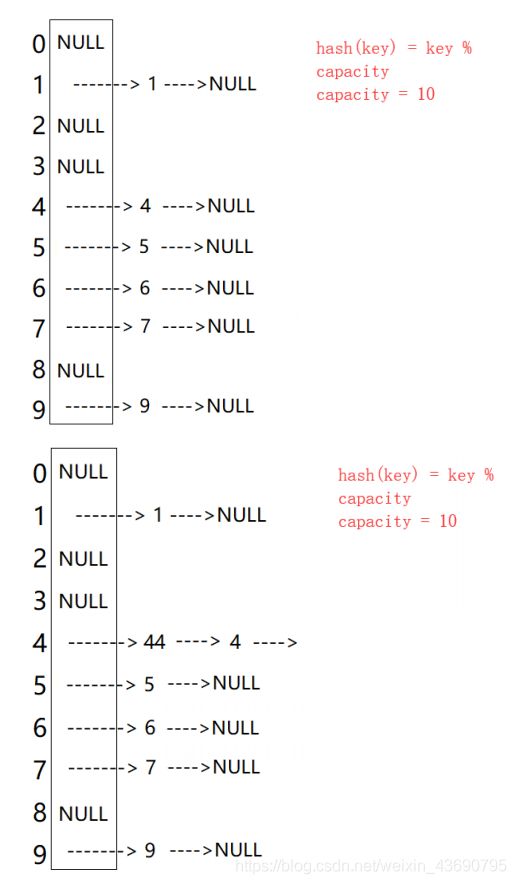哈希表详解
哈希概念
顺序结构以及平衡树中,元素关键码与其存储位置之间没有对应的关系,因此在查找一个元素时,必须要经过关键码的多次比较。顺序查找时间复杂度为O(N),平衡树中为树的高度,即O(log2N),搜索的效率取决于搜索过程中元素的比较次数。
理想的搜索方法:可以不经过任何比较,一次直接从表中得到要搜索的元素。 如果构造一种存储结构,通过某种函数(hashFunc)使元素的存储位置与它的关键码之间能够建立一一映射的关系,那么在查找时通过该函数可以很快找到该元素。
当向该结构中:
- 插入元素
根据待插入元素的关键码,以此函数计算出该元素的存储位置并按此位置进行存放 - 搜索元素
对元素的关键码进行同样的计算,把求得的函数值当做元素的存储位置,在结构中按此位置取元素比较,若关键码相等,则搜索成功
该方式即为哈希(散列)方法,哈希方法中使用的转换函数称为哈希(散列)函数,构造出来的结构称为哈希表(Hash Table)(或者称散列表)
例如:数据集合{1,7,6,4,5,9};
哈希函数设置为:hash(key) = key % capacity; capacity为存储元素底层空间总的大小。

用该方法进行搜索不必进行多次关键码的比较,因此搜索的速度比较快。但是有一个问题:按照上述哈希方式,向集合中插入元素44,会出现什么问题?
哈希冲突
对于两个数据元素的关键字 Ki和 Kj(i != j),有 Ki != Kj,但有:Hash(Ki) == Hash(Kj),即:不同关键字通过相同哈希哈数计算出相同的哈希地址,该种现象称为哈希冲突或哈希碰撞。
把具有不同关键码而具有相同哈希地址的数据元素称为“同义词"。
发生哈希冲突该如何处理呢?
哈希函数
引起哈希冲突的一个原因可能是:哈希函数设计不够合理。 哈希函数设计原则:
- 哈希函数的定义域必须包括需要存储的全部关键码,而如果散列表允许有m个地址时,其值域必须在0到m-1之间
- 哈希函数计算出来的地址能均匀分布在整个空间中
- 哈希函数应该比较简单
常见哈希函数
1.直接定址法(常用)
取关键字的某个线性函数为散列地址:Hash(Key)= A*Key + B。优点:简单、均匀。缺点:需要事先知道关键字的分布情况。使用场景:适合查找比较小且连续的情况。
2.除留余数法(常用)
设散列表中允许的地址数为m,取一个不大于m,但最接近或者等于m的质数p作为除数,按照哈希函数:Hash(key) = key% p(p<=m),将关键码转换成哈希地址。
注意:哈希函数设计的越精妙,产生哈希冲突的可能性就越低,但还是无法避免哈希冲突
哈希冲突解决
解决哈希冲突两种常见的方法是:闭散列和开散列
闭散列
闭散列:也叫开放定址法,当发生哈希冲突时,如果哈希表未被装满,说明在哈希表中必然还有空位置,那么可以把key存放到冲突位置中的“下一个” 空位置中去。那如何寻找下一个空位置呢?
1.线性探测
比如之前图中的场景,现在需要插入元素44,先通过哈希函数计算哈希地址,hashAddr为4,因此44理论上应该插在该位置,但是该位置已经放了值为4的元素,即发生哈希冲突。
线性探测:从发生冲突的位置开始,依次向后探测,直到寻找到下一个空位置为止。
插入:
- 通过哈希函数获取待插入元素在哈希表中的位置
- 如果该位置中没有元素则直接插入新元素,如果该位置中有元素发生哈希冲突,使用线性探测找到下一个空位置,插入新元素

删除:
采用闭散列处理哈希冲突时,不能随便物理删除哈希表中已有的元素,若直接删除元素会影响其他元素的搜索。比如删除元素4,如果直接删除掉,44查找起来会受影响。因此线性探测采用标记的伪删除法来删除一个元素。
//哈希表每个空间给个标记
//EMPTY此位置空,EXIST此位置已经有元素,DELETE元素已经删除
enum State
{
EMPTY,
EXIST,
DELETE
};
线性探测的实现
#include void CheckCapacity()
{
if (_size * 10 / _table.size() >= 7)
{
int newCapacity = _table.size() * 2;
HashTable<K, T, KeyOfT> newHT(newCapacity);
for (size_t i = 0; i < _table.size(); ++i)
{
if (_table[i]._state == EXIST)
{
newHT.Insert(_table[i]._data);
}
}
_table.swap(newHT._table);
}
}
线性探测优点:实现非常简单
线性探测缺点:一旦发生哈希冲突,所有的冲突连在一起,容易产生数据“堆积”,即:不同关键码占据了可利用的空位置,使得寻找某关键码的位置需要许多次比较,导致搜索效率降低。如何缓解呢?
2.二次探测
线性探测的缺陷是产生冲突的数据堆积在一块,这与其找下一个空位置有关系,因为找空位置的方式就是挨着往后逐个去找,因此二次探测为了避免该问题,找下一个空位置的方法为:Hi = (H0 + i2) % m,或者:Hi = (H0 - i2) % m。其中:i = 1,2,3…,是通过散列函数Hash(x)对元素的关键码 key 进行计算得到的位置,m是表的大小。 对于之前图中如果要插入44,产生冲突,使用解决后的情况为:


研究表明:当表的长度为质数且表负载因子a不超过0.5时,新的表项一定能够插入,而且任何一个位置都不会被探查两次。因此只要表中有一半的空位置,就不会存在表满的问题。在搜索时可以不考虑表装满的情况,但在插入时必须确保表的负载因子a不超过0.5,如果超出必须考虑增容。
因此:闭散列最大的缺陷就是空间利用率比较低,这也是哈希的缺陷。
开散列
开散列法又叫链地址法(开链法),首先对关键码集合用散列函数计算散列地址,具有相同地址的关键码归于同一子集合,每一个子集合称为一个桶,各个桶中的元素通过一个单链表链接起来,各链表的头结点存储在哈希表中。

从上图可以看出,开散列中每个桶中放的都是发生哈希冲突的元素。
开散列增容
桶的个数是一定的,随着元素的不断插入,每个桶中元素的个数不断增多,极端情况下,可能会导致一个桶中链表节点非常多,会影响的哈希表的性能,因此在一定条件下需要对哈希表进行增容,那该条件怎么确认呢?开散列最好的情况是:每个哈希桶中刚好挂一个节点,再继续插入元素时,每一次都会发生哈希冲突,因此,在元素个数刚好等于桶的个数时(即负载因子等于1的时候),可以给哈希表增容。但是随着数据量过大,一个桶中链表节点仍然会非常多,这个时候我们可以将单链表换成平衡树挂在每一个桶中,很大程度上提高了效率。
void CheckCapacity()
{
KeyOfT koft; //通过仿函数获取K或者K/V模型中的K
//如果负载因子==1,则扩容
if (_num == _table.size())
{
vector<Node*> newTable;
size_t newSize = _table.size() == 0 ? 10 : _table.size() * 2;
newTable.resize(newSize);
for (size_t i = 0; i < _table.size(); ++i)
{
Node* cur = _table[i];
while (cur)
{
//重新计算data在newTable中的位置
//HashFunc函数是用来将K中的数据类型转换成整型方便寻找哈希地址
size_t index = HashFunc(koft(cur->_data)) % newTable.size();
//将_table中的data搬移到newTable中
Node* next = cur->_next;
cur->_next = newTable[index];
newTable[index] = cur;
cur = next;
}
_table[i] = nullptr;
}
_table.swap(newTable);
}
}
只能存储key为整形的元素,其他类型怎么解决?
实际运用中,key一般为string类型
字符串哈希算法
template<class K>
struct _Hash
{
const K& operator()(const K& key)
{
return key;
}
};
//模板特化,字符串转整型
template<>
struct _Hash<string>
{
size_t operator()(const string& key)
{
//BKDR算法
size_t hash = 0;
for (size_t i = 0; i < key.size(); ++i)
{
hash *= 131;
hash += key[i];
}
return hash;
}
};
开散列的实现
#include 测试用例:
void Test1()
{
HashOpen<int, int, SetKeyOfT<int>> h;
h.Insert(4);
h.Insert(14);
h.Insert(24);
h.Insert(6);
h.Insert(16);
h.Insert(46);
h.Insert(8);
h.Insert(21);
h.Insert(5);
h.Insert(85);
h.Insert(27);
auto pos = h.Find(24);
if (pos)
{
cout << "找到了" << endl;
}
else
{
cout << "没找到" << endl;
}
bool ret = h.Erase(24);
if (ret)
{
cout << "删除成功" << endl;
}
else
{
cout << "删除失败" << endl;
}
}
void Test2()
{
HashOpen<int, pair<int, int>, MapKeyOfT<int, int>> h;
h.Insert(make_pair(3, 3));
h.Insert(make_pair(23, 23));
h.Insert(make_pair(13, 13));
h.Insert(make_pair(5, 5));
h.Insert(make_pair(85, 85));
h.Insert(make_pair(35, 35));
h.Insert(make_pair(44, 44));
h.Insert(make_pair(56, 56));
auto pos = h.Find(35);
if (pos)
{
cout << "找到了" << endl;
}
else
{
cout << "没找到" << endl;
}
bool ret = h.Erase(35);
if (ret)
{
cout << "删除成功" << endl;
}
else
{
cout << "删除失败" << endl;
}
}
void Test3()
{
HashOpen<string, string, SetKeyOfT<string>> h;
h.Insert("BSTree");
h.Insert("AVLTree");
h.Insert("RBTree");
cout << h.HashFunc("BSTree") << endl;
cout << h.HashFunc("AVLTree") << endl;
cout << h.HashFunc("RBTree") << endl;
}
开散列与闭散列比较
应用链地址法处理溢出,需要增设链接指针,似乎增加了存储开销。事实上: 由于开地址法必须保持大量的空闲空间以确保搜索效率,而表项所占空间又比指针大的多,所以使用链地址法反而比开地址法节省存储空间。
模拟实现unordered_map、unordered_set(底层哈希)
#pragma once
#include #pragma once
#include "HashOpen.hpp"
namespace Unordered_Map
{
template<class K, class V>
class unordered_map
{
struct MapKeyOfT
{
const K& operator()(const pair<K, V>& kv)
{
return kv.first;
}
};
public:
typedef typename HashOpen<K, pair<K, V>, MapKeyOfT>::iterator iterator;
iterator begin()
{
return _h.begin();
}
iterator end()
{
return _h.end();
}
pair<iterator, bool> insert(const pair<K, V>& kv)
{
return _h.Insert(kv);
}
V& operator[](const K& key)
{
pair<iterator, bool> ret = _h.Insert(make_pair(key, V()));
return ret.first->second;
}
private:
HashOpen<K, pair<K, V>, MapKeyOfT> _h;
};
void test_unordered_map()
{
unordered_map<string, string> dict;
dict.insert(make_pair("sort", "排序"));
dict.insert(make_pair("left", "左边"));
dict.insert(make_pair("string", "字符串"));
dict["left"] = "修改左边";
dict["end"] = "尾部";
//unordered_map::iterator it = dict.begin();
auto it = dict.begin();
while (it != dict.end())
{
cout << it->first << ":" << it->second << endl;
++it;
}
cout << endl;
}
}
#pragma once
#include "HashOpen.hpp"
namespace Unordered_Set
{
template<class K>
class unordered_set
{
struct SetKeyOfT
{
const K& operator()(const K& key)
{
return key;
}
};
public:
typedef typename HashOpen<K, K, SetKeyOfT>::iterator iterator;
iterator begin()
{
return _h.begin();
}
iterator end()
{
return _h.end();
}
pair<iterator, bool> insert(const K& k)
{
return _h.Insert(k);
}
private:
HashOpen<K, K, SetKeyOfT> _h;
};
void test_unordered_set()
{
unordered_set<int> s;
s.insert(1);
s.insert(5);
s.insert(4);
s.insert(2);
unordered_set<int>::iterator it = s.begin();
while (it != s.end())
{
cout << *it << " ";
++it;
}
cout << endl;
}
}
